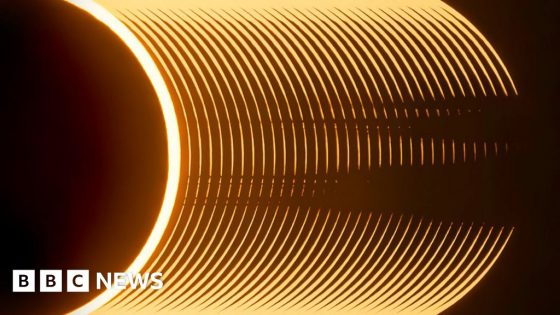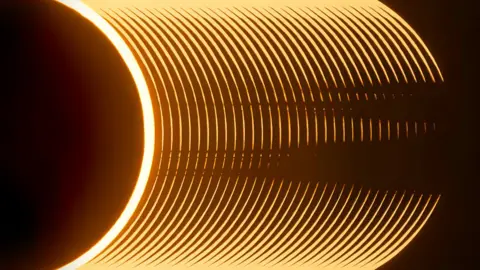 Ryan Imperio
Ryan ImperioRyan Imperio has been named the Royal Observatory Greenwich’s Astronomy Photographer of the Year for a photograph that captures the progression of Baily’s beads during the 2023 annular eclipse.
Baily’s beads are formed when sunlight shines through the valleys and craters of the Moon’s surface, and are only briefly visible when an eclipse is beginning or ending.
Kerry-Ann Lecky Hepburn, one of the judges and a meteorologist, said the winning image was an “impressive dissection of the fleeting few seconds” when Baily’s beads can be seen.
“This image left me captivated and amazed,” she added.
Mr Imperio, who won £10,000 for winning the competition overall, said he “never expected to be selected” and was “both thrilled and honoured” with the award.
For the 2024 competition there were over 3,500 entries from 58 countries.
Mr Imperio’s entry was also among the winners selected for the Our Sun category of the competition.
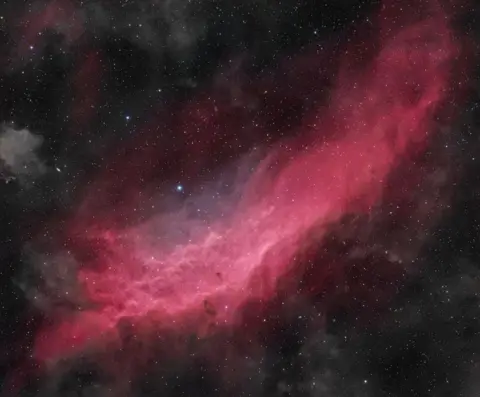 Daniel Borsari
Daniel BorsariThe Young Astronomy Photographer of the Year award was won by Daniel Borsari for his image “NGC NGC 1499, A Dusty California”.
This image features the California Nebula – also known as NGC 1499 – an emission nebula in the constellation of Perseus.
The image was created by taking lots of pictures of the nebula and combining them into one.
It’s located about 1,000 light years from Earth and it’s visible thanks to the ionization of gases by the blue giant star Persei.
Neal White, a prize judge and an artist, said Mr Borsari’s image showed “the future of astronomy photography being fearlessly, and openly, taken forward by a new generation”.
See more of the winning images:
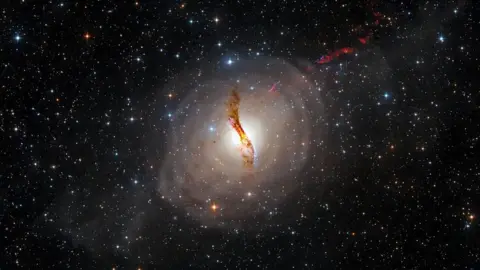 Bence Tóth / Péter Feltóti
Bence Tóth / Péter FeltótiBence Tóth and Péter Feltót from Hungary were the winners in the Galaxies category.
Their picture shows the galaxy NGC 5128 and its relativistic jet – beams of radiation and particles travelling close to the speed of light.
The galaxy can only be seen from the southern hemisphere, so the photographers travelled to Namibia to capture the image.
 Larryn Rae
Larryn RaeLarryn Rae triumphed in the Aurorae category with a picture of the aurora australis over Queenstown, New Zealand.
The image is a panorama composed of 19 pictures, capturing the pink beams of solar radiation that lit up the sky in February 2023.
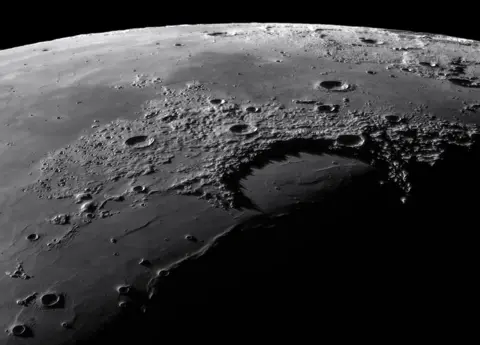 by Gábor Balázs
by Gábor Balázs“Shadow peaks of Sinus Iridum” by Gábor Balázs, from Hungary, took the top spot in the Our Moon category.
The photograph captures Sinus Iridum – also known as the Bay of Rainbows – a massive crater 260km across.
Part of the crater’s wall has effectively been destroyed, giving it the appearance of a bay.
The photographer used a monochrome camera with a filter to capture the area.
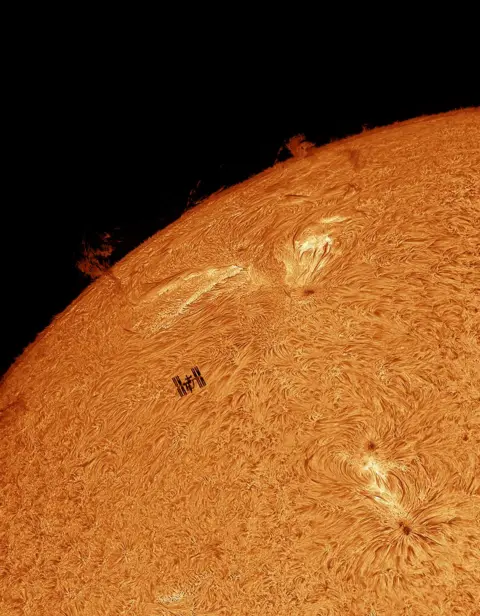 Tom Williams
Tom WilliamsTom Williams from the UK was first in the People and Space category with his image which captured the silhouette of the International Space Station (ISS) on a backdrop of the Sun.
Crossing the field-of-view in just 0.2 seconds, ISS transits of the Sun are particularly rare to see on Earth.
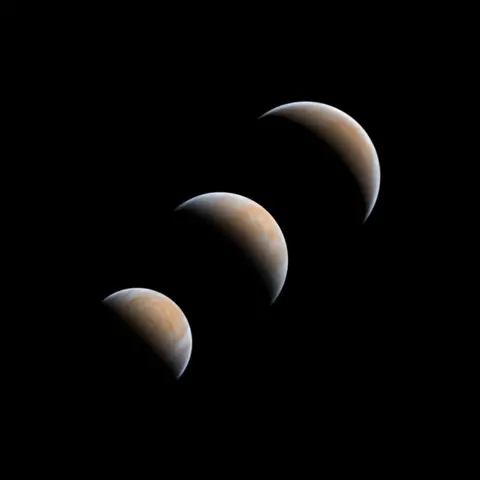 Tom Williams
Tom WilliamsMr Williams was also selected as the winner in the Planets, Comets and Asteroids category.
His composite shows the phases of Venus, using ultra-violet and infrared filters that reveal the cloud structure within the upper atmosphere of the planet.
 Tom Rae
Tom Rae Tom Rae captured this image of peaks of the Tasman Valley in New Zealand set against the night sky of the southern hemisphere during summer.
It includes the hydrogen clouds of the Gum Nebula – the red blob near the centre – as well as a band of the Milky Way.
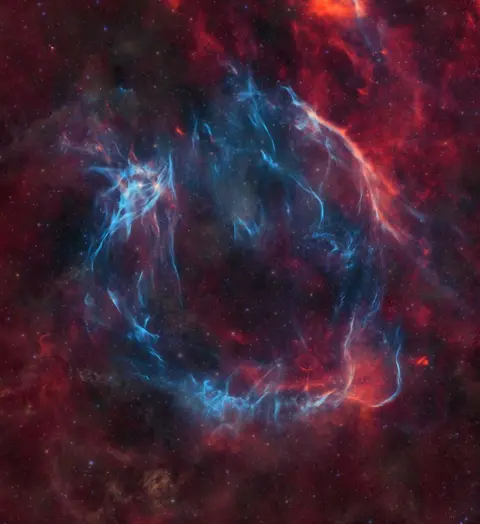 Marcel Drechsler, Bray Falls, Yann Sainty, Nicolas Martino, Richard Galli
Marcel Drechsler, Bray Falls, Yann Sainty, Nicolas Martino, Richard GalliThis impressive photograph is the result of 3,559 frames, 260 hours of exposure time and telescopes located on three continents.
The team worked to explore and photograph a previously unknown gigantic supernova remnant (SNR) in the centre of the famous constellation Cassiopeia.
“SNR G107.5-5.2, The Nereides Nebula in Cassiopeia” was created by Marcel Drechsler in Germany, Bray Falls in the USA, and Yann Sainty, Nicolas Martino and Richard Galli in France.
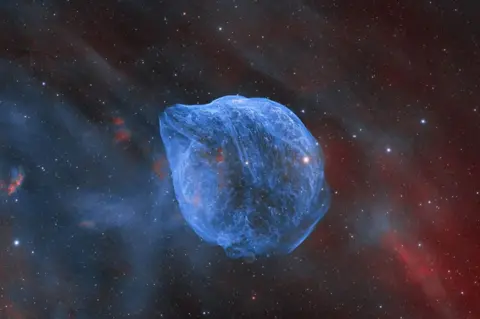 Xin Feng / Miao Gong
Xin Feng / Miao GongThe Sir Patrick Moore Prize for Best Newcomer award went to Xin Feng and Miao Gong from China.
Their image is of SH2-308, the Dolphin Head Nebula, which appears low in the northern hemisphere and can only be seen for five hours a day.
Their image comprises a total of ten days of shooting.
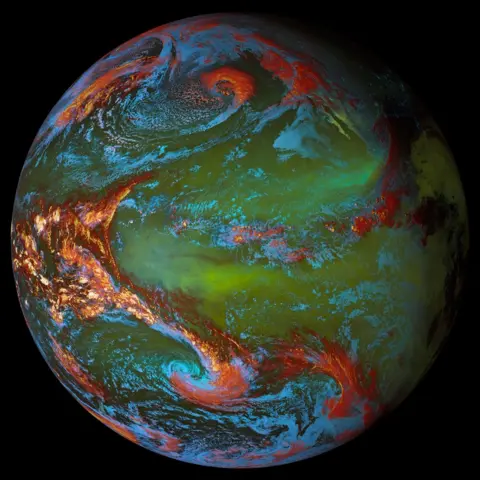 Sergio Díaz Ruiz
Sergio Díaz RuizSergio Díaz Ruiz from Spain was awarded the Annie Maunder Prize for Image Innovation for his image of Earth.
This image was created by mixing the 16 bands monitored by the GOES-18 weather satellite to encode land masses, oceans and atmospheric features as different colours.
The winning and highly commended images will be on display in exhibition at the National Maritime Museum, London from 13 September 2024.
Source Agencies

